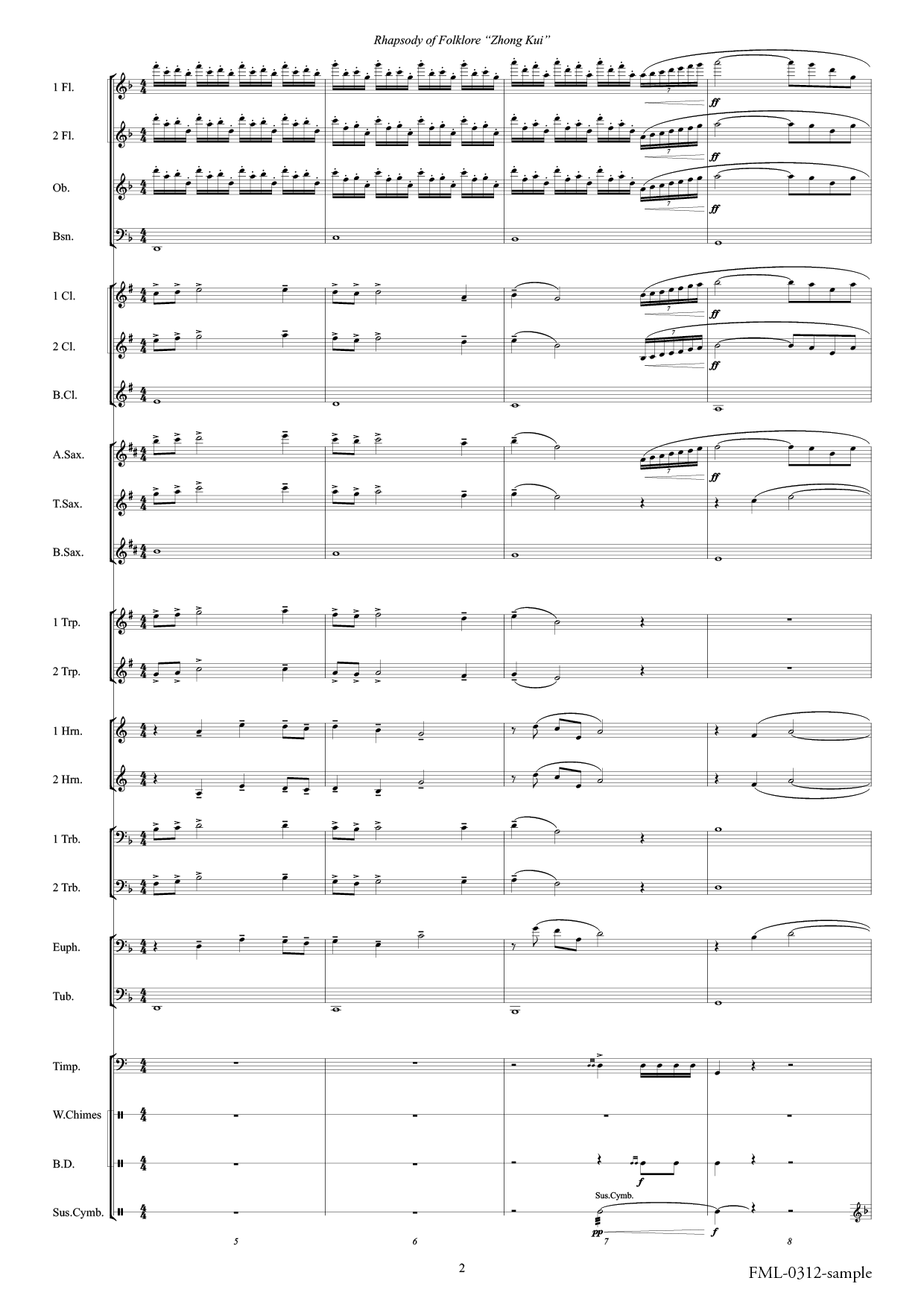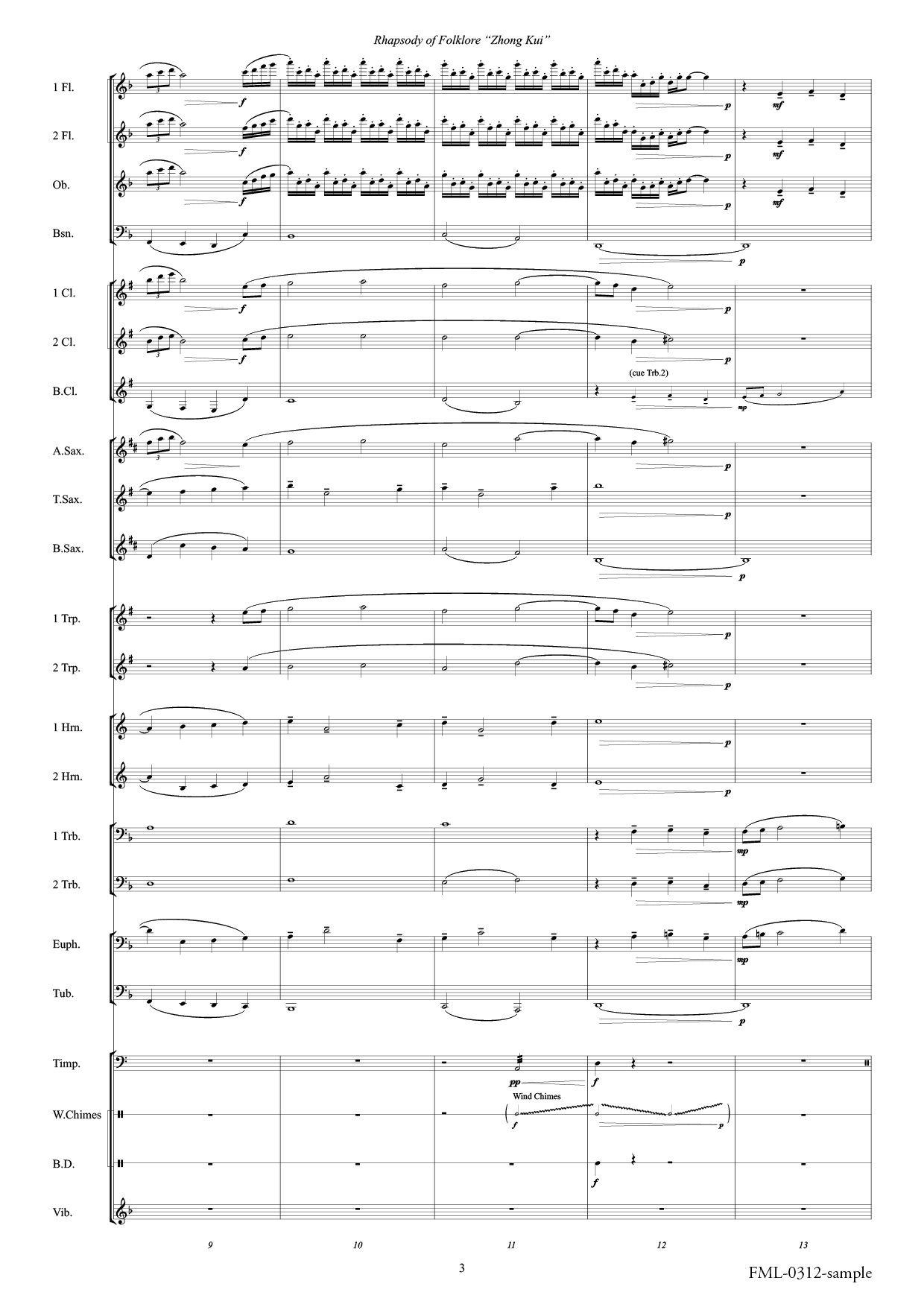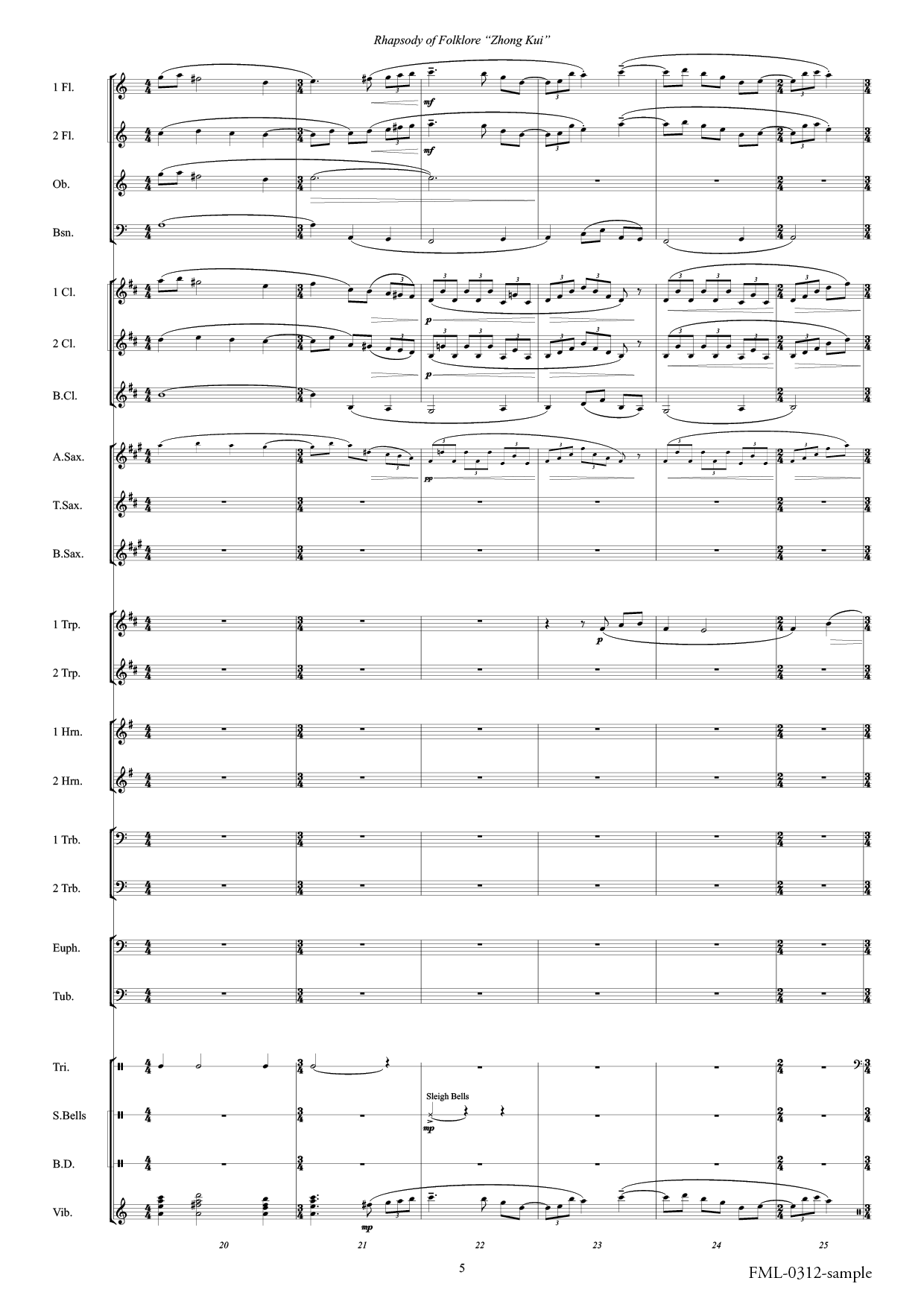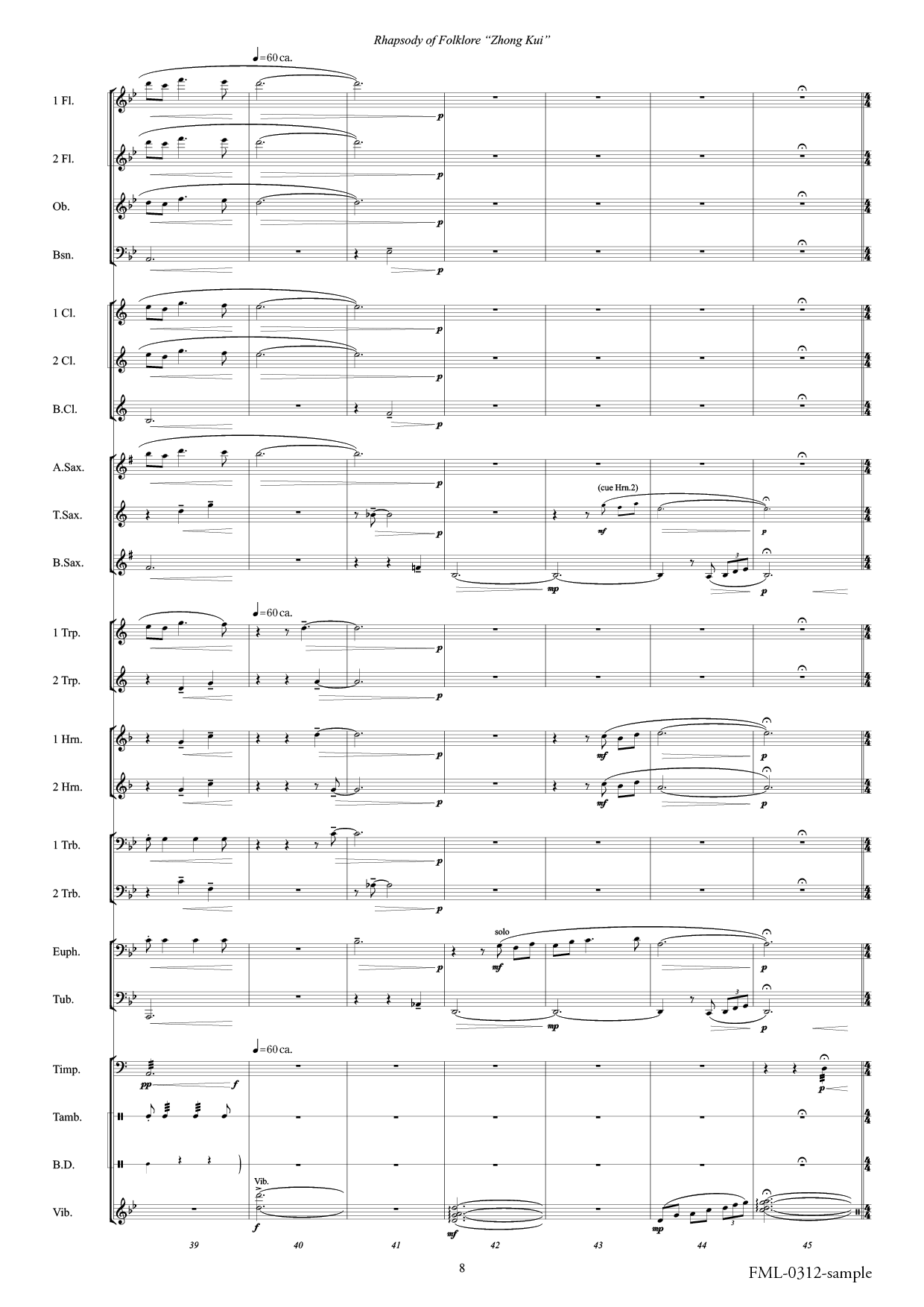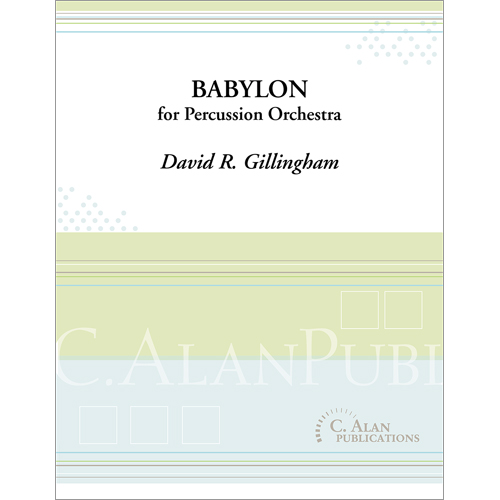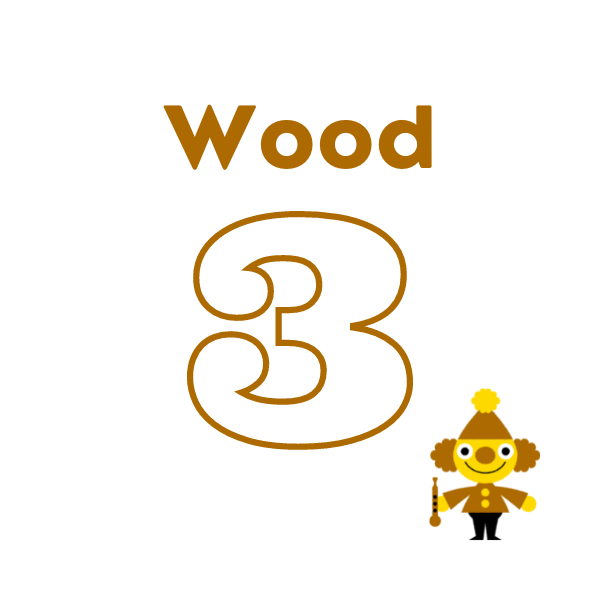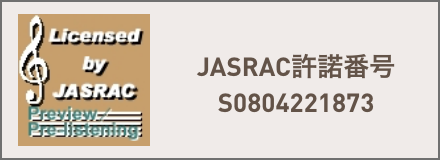12月25日15時を持ちまして、
2025年内出荷の注文受付を終了いたしました。
以降のご注文は年明け
【 2026年1月7日(水)以降順次出荷 】
となります。予めご了承ください。
本年もたくさんのご愛顧を賜りありがとうございました。
よいお年をお迎えください。
吹奏楽のための狂詩曲~鍾馗(しょうき)の伝説による〈小編成版〉:近藤礼隆 [吹奏楽スコア]
・1配送につき税込11,000円以上のご注文で国内送料無料
・コンビニ後払い、クレジットカード、銀行振込利用可
・[在庫あり]は営業日正午までのご注文で即日出荷
・International Shipping
- 作曲: 近藤礼隆
- 編成:13 - 21パート
- 演奏時間:0:07:00
- グレード:4
- スタディスコア(演奏・編曲利用不可)
フォスターミュージック/FML-0312FS
- 概要
- 編成/曲目
- 補足
- ENGLISH
吹奏楽のための狂詩曲~鍾馗(しょうき)の伝説による〈小編成版〉
昨年春の緊急事態宣言時、エンタメ業界・芸術業界で様々な「オンライン配信」が行われましたが、その中で私は、日本各地の伝統芸能の配信をよく見るようになりました。特に、島根県西部・広島県北西部に室町時代から伝わる「石見神楽」に興味を持ちました。軽快かつ激しい囃子と舞いが特徴で、現地では子供から高齢者にまで幅広く人気があるそうです。
「石見神楽」には30種類の演目がありますが、当時、多くの団体が「鍾馗」という演目を配信していました。この演目は病魔退散を願うものであり、コロナ禍の早期終息を願い特別奉納されていた、という背景があったようです。これをきっかけに、自分も「鍾馗」を題材に表現してみたい、という思いが次第に強まっていきました。
そもそも「鍾馗」(しょうき)とは中国を起源とする神で、日本においても古くから信仰されています。京都の民家では軒先に鍾馗の人形が飾られていたり、関東でも端午の節句に鍾馗の人形が飾られたりと、各地の風習として鍾馗の信仰が根付いていると言えるでしょう。
その鍾馗について、以下のような言い伝えがあります。
唐の皇帝・玄宗は病に伏し、高熱の中である夢を見た。
夢の中で小鬼がいたずらをしながら宮廷内をまわり、その手が玄宗にかかろうとした瞬間、髭面の大男が現れて小鬼を退治した。「鍾馗」と名乗るその大男が言うには、「科挙(当時の官僚登用試験)の落第を恥じて自殺した際、帝に手厚く葬っていただいた。その恩に報いるために参りました」、と。夢から覚めると、玄宗の病はすっかり癒えて元気になっていたと言う。
この伝説から鍾馗は、厄除け(特に疫病除け)の神として各地で信仰を広げていったのです。
さて、この曲は大きく緩・急・緩の構成になっており、それぞれ以下のような場面をイメージしています。
1. 緩:鍾馗の過去/唐の都・長安の栄華
2. 急:玄宗の夢(小鬼のいたずら、鍾馗の登場と鬼退治)
3. 緩:玄宗の夢(鍾馗の話)/玄宗の回復・伝説への昇華
この一年、コロナ禍で様々なことが一変し、もちろん吹奏楽の現場や、作曲家の仕事にも非常に大きな影響が出ています。その終息への願いが、自然と今回の作曲の動機になったのだと思います。私なりの祈りが、どうか届きますように。(2021年4月 近藤礼隆)
<楽譜についての注意事項>
本作品は、中編成版と小編成版とで、曲の冒頭(中編成版の練習番号B以前/小編成版の練習番号A以前)の内容が大幅に異なります。スコアの比較等をされる際にはご注意ください。
仕様
- アーティスト
- 作曲: 近藤礼隆
- 演奏形態
- 吹奏楽
- 編成
- 極小編成 / 13 - 21パート
- 演奏時間
- 0:07:00
- グレード
- 4
- 商品形態
- スコア
- 出版社 / 品番
- フォスターミュージック / FML-0312FS
- JANコード
- 4560318478268
- 発売日(年)
- 2022/08/03
楽器編成
- Full Score
- Flute 1
- Flute 2 (optional)
- Oboe (optional)
- Bassoon (optional)
- Bb Clarinet 1
- Bb Clarinet 2 (optional)
- Bass Clarinet
- Alto Saxophone
- Tenor Saxophone
- Baritone Saxophone (optional)
- Trumpet 1
- Trumpet 2 (optional)
- Horn 1
- Horn 2 (optional)
- Trombone 1
- Trombone 2 (optional)
- Euphonium
- Tuba
- Percussion 1(Timpani, Triangle, Finger Cymbals)
- Percussion 2 (Bass Drum, Wind Chimes, Sleigh Bells, Wood Blocks, Tambourine, Bongos, Hi-Hat, Snare Drum, Cymbals)
- Percussion 3 (Suspended Cymbal, Tam-tam, Cymbals, Vibraphone, Sleigh Bells, Tambourine, Xylophone, Glockenspiel)
近藤礼隆(Noritaka Kondo)
1995年埼玉県東松山市生まれ、千葉県柏市育ち。渋谷教育学園幕張高等学校、東京藝術大学音楽学部音楽環境創造科を卒業。
作曲を植野洋美、西岡龍彦の各氏に、音楽理論を故・山口博史氏に師事。
これまでに、第33回朝日作曲賞入選(2024年度全日本吹奏楽コンクール課題曲採用)、第52回JBA「下谷賞」受賞、21世紀の吹奏楽 第22回“響宴”入選、第12回日本管打・吹奏楽学会作曲賞佳作。アニメーション映像やオーディオドラマなど、音楽を担当した作品も多数。
好きな作曲家は伊福部昭とスティーヴ・ライヒ。
Web: https://nori-kn.tumblr.com/
- サイズ
- A4/1cm未満
RHAPSODY OF FOLKLORE “ZHONG KUI” - SMALL BAND VER.
Ever since the COVID19 pandemic in the spring of 2020, the Japanese entertainment industry has seen a variety of online streaming. In the midst of all this, I was able to see streams of traditional arts from all over Japan, and I developed a particular interest in the Iwami Kagura theatrical dance from the western Shimane and northwestern Hiroshima Prefectures, which has been handed down through the years since the Muromachi Period. Known for their characteristic way of dancing to light, vibrant musical accompaniment, these dances are apparently local sensations with a wide popularity among everyone from children to the elderly.
There are thirty different varieties of Iwami Kagura performance, but at the time most troupes’ broadcasts were of Zhong Kui performances. These performances are pleas for the eradication of disease, and in that context, were seemingly dedicated to a wish that the covid pandemic would end as soon as possible. With something like that to catch my interest, I, too, began to feel more and more inspired to create something that touched on the topic of Zhong Kui.
After all, Zhong Kui, a deity said to prevent plauge, finds his origins in China, but since ancient times has had devotees in Japan as well. In Kyoto, private houses decorate their eaves with figures of Zhong Kui. In Kanto, figures of Zhong Kui are used as decorations during Tango no Sekku, the Boy’s Festival. Faith in Zhong Kui has its roots all over the country, and each tradition has its own unique style.
One tale about Zhong Kui goes as follows:
The Emperor Xuanzong of the Tang Dynasty fell ill, and wracked by fever, began to dream.
...In the dream, he saw two little imps making mischief inside the palace. The imps turned their attention towards Xuanzong, but in that moment an imposing figure with a beard appeared and banished them.
This towering man said his name was Zhong Kui, and claimed to have committed suicide out of shame for failing the Imperial Examination, only to be buried through the Emperor’s own gesture of kindness. He told Xuanzong that he had come to repay that debt. When Emperor Xuanzong awoke from this dream it is said that he had been restored to full health, his illness healed.
Through this legend, Zhong Kui became revered all over as a divinity who could ward against evil.
With that in mind, this song’s structure is broadly divided into slow, fast, slow tempo sections, which call to mind the following scenes.
1 Zhong Kui’s past, and the glory of the Tang capital Chang’an
2 Xuanzong’s dream (the imps’ mischief and Zhong Kui appearing to banish them)
3 Xuanzong’s dream (his conversation with Zhong Kui) / Xuanzong’s recovery and the story’s ascension to the status of legend
In the last year, the pandemic has wrought a lot of drastic changes. Wind orchestra venues and musician’s jobs have, of course, not been spared from covid’s influence. I think it’s only natural that this composition, too, would be motivated by a wish to see an end to the pandemic. So, this is my own prayer, in my own way, and I only hope my wish shines through.
April 2021, Noritaka Kondo
*This piece of music has both a mediumlength and shorterlength version, and the beginning of the song (Prior to rehearsal letter B in the medium version and rehearsal letter A in the short version) varies greatly between them. Please take care when making comparisons, etc., between the scores.
Specifications
- ARTIST
- Composer: Noritaka KONDO
- INSTRUMENTATION
- Windband / less than 15 Players
- DURATION
- 0:07:00
- GRADE
- 4
- PRODUCT TYPE
- STUDY SCORE (PARTS Sold separately)
- PUBLISHER / Code
- fostermusic Inc. / FML-0312FS
- JAN
- 4560318478268
- RELEASE
- 2022/08/03
- OVERSEAS SHIPMENT
- Yes
- EUROPEAN PARTS
- Not Included

![吹奏楽のための狂詩曲~鍾馗(しょうき)の伝説による〈小編成版〉:近藤礼隆 [吹奏楽スコア]](/html/upload/save_image/FML0312_3.png)
